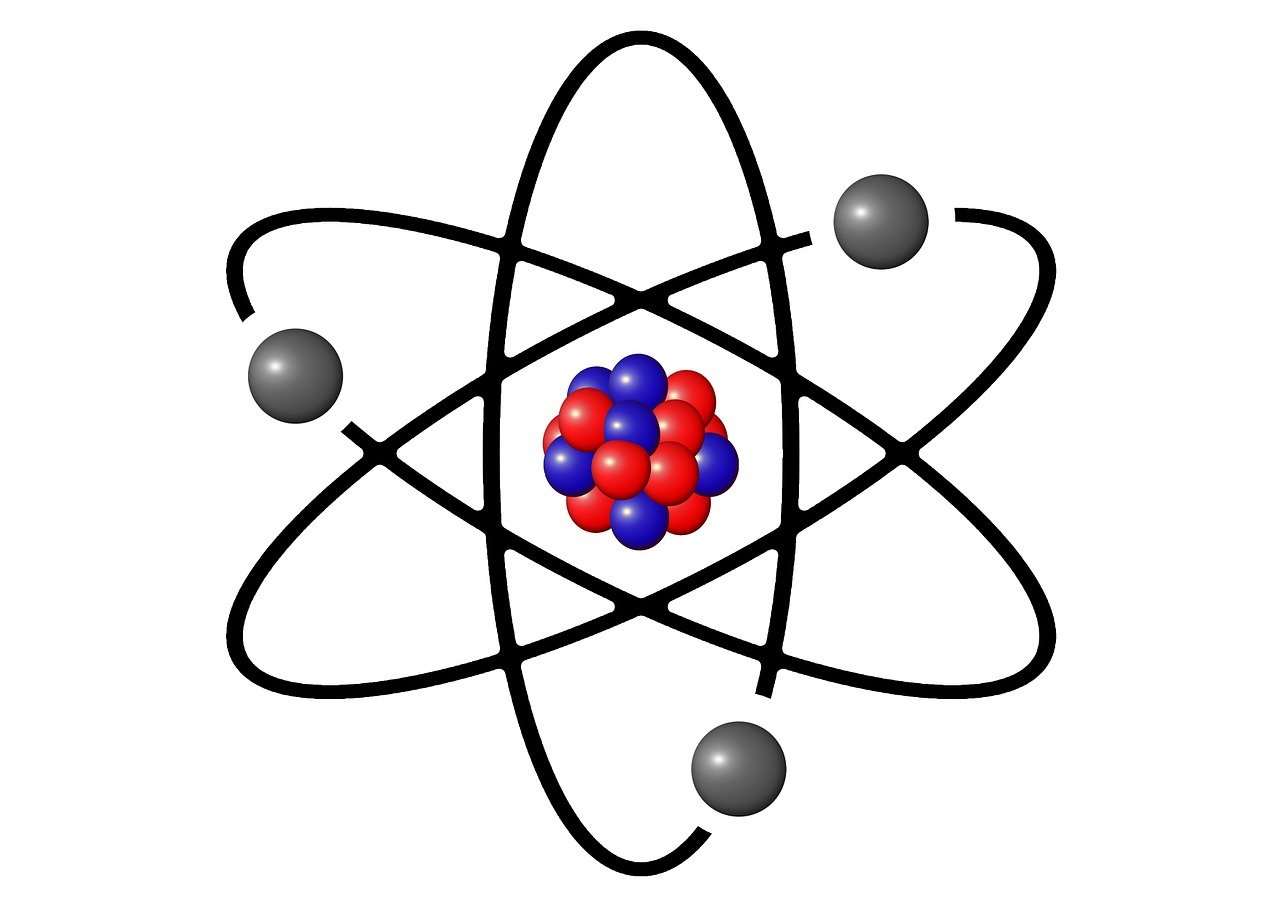Atomic Mass Calculator - Find Atomic Mass of Elements
Result:
Atomic Mass Definition and Formula
An atom's mass comes from the tiny particles called protons, neutrons, and electrons. However, electrons don't add much to the mass because they are 1,836 times lighter than protons.
Scientists usually measure an atom's mass in atomic mass units (amu) or daltons (Da). One amu equals 1/12 of the mass of a carbon-12 atom. This makes 1 amu equal to 1.66 x 10^-27 kilograms.
To calculate the approximate atomic mass in amu, you add up the number of protons and neutrons. So the atomic mass formula is:
Atomic mass (amu) ≈ Number of protons + Number of neutrons
Or written with symbols:
A = Z + N
Where:
A = Mass number (total protons and neutrons)
Z = Number of protons
N = Number of neutrons
The actual mass is slightly less because of a tiny mass loss from binding energy according to E=mc^2. But this calculator doesn't include that very small effect.
How To Find Atomic Mass with this Calculator
Follow these steps to find an atom's mass:
- Enter the number of protons. The calculator warns if over 118 (the current highest).
- Enter the number of neutrons. It warns if over 177 (current max).
- It shows the atomic mass in amu (default units) and also in kilograms (kg).
- It also displays the mass number.

Understanding Atomic Structure and Mass Calculations
Atomic mass calculations form the foundation of chemistry and physics, helping us understand the fundamental building blocks of matter. Every atom consists of a nucleus containing protons and neutrons, surrounded by electrons in orbital shells. The mass of an atom is primarily determined by its nuclear particles, as electrons contribute negligible mass.
Components of Atomic Mass
The atomic mass represents the total mass of an atom, measured in atomic mass units (amu) or daltons (Da). Understanding each component helps in accurate calculations:
- Protons: Positively charged particles with mass ≈ 1.007 amu each
- Neutrons: Neutral particles with mass ≈ 1.009 amu each
- Electrons: Negatively charged particles with mass ≈ 0.0005 amu each
Isotopes and Average Atomic Mass
Elements exist in multiple forms called isotopes, which have the same number of protons but different numbers of neutrons. This variation affects the atomic mass and requires understanding of weighted averages for accurate calculations.
Common Isotope Examples
Carbon Isotopes:
- Carbon-12: 6 protons + 6 neutrons = 12 amu (98.93% abundance)
- Carbon-13: 6 protons + 7 neutrons = 13 amu (1.07% abundance)
- Carbon-14: 6 protons + 8 neutrons = 14 amu (trace amounts)
Average atomic mass of carbon = (12 × 0.9893) + (13 × 0.0107) = 12.011 amu
Uranium Isotopes:
- Uranium-235: 92 protons + 143 neutrons = 235 amu (0.72% abundance)
- Uranium-238: 92 protons + 146 neutrons = 238 amu (99.27% abundance)
Average atomic mass of uranium = (235 × 0.0072) + (238 × 0.9927) = 238.03 amu
Atomic Mass vs. Mass Number
Understanding the distinction between atomic mass and mass number is crucial for accurate chemistry calculations:
- Mass Number (A): The total count of protons and neutrons in the nucleus (always a whole number)
- Atomic Mass: The actual mass of the atom including binding energy effects (usually not a whole number)
Binding Energy and Mass Defect
Einstein's E=mc² equation explains why atomic masses are slightly less than the sum of individual particle masses. When protons and neutrons bind together in the nucleus, a small amount of mass converts to binding energy, creating a "mass defect."
Mass Defect Calculation
For Helium-4 nucleus:
Expected mass: (2 × 1.007276) + (2 × 1.008665) = 4.031882 amu
Actual mass: 4.002603 amu
Mass defect: 4.031882 - 4.002603 = 0.029279 amu
This mass defect represents the nuclear binding energy that holds the nucleus together.
Applications of Atomic Mass Calculations
Nuclear Chemistry
Atomic mass calculations are essential for:
- Predicting radioactive decay patterns
- Calculating half-lives of isotopes
- Determining nuclear reaction energies
- Understanding nuclear stability
Chemical Reactions and Stoichiometry
Accurate atomic masses enable:
- Calculating molecular weights
- Determining reaction yields
- Balancing chemical equations
- Converting between moles and grams
Advanced Atomic Mass Concepts
Relative Atomic Mass Scale
The atomic mass scale uses Carbon-12 as the reference standard, assigned exactly 12 amu. All other atomic masses are expressed relative to this standard:
1 amu = 1/12 × mass of Carbon-12 atom = 1.66054 × 10⁻²⁷ kg
Precision in Atomic Mass Measurements
Modern mass spectrometry allows extremely precise atomic mass measurements:
- Time-of-Flight Mass Spectrometry: Measures mass-to-charge ratios
- Magnetic Sector Mass Spectrometry: Uses magnetic fields for separation
- Quadrupole Mass Spectrometry: Employs oscillating electric fields
Periodic Table Trends in Atomic Mass
Atomic mass generally increases as you move across periods and down groups in the periodic table, with some exceptions due to isotope abundance variations.
Period Trends
Moving left to right across a period, atomic mass typically increases as proton and neutron numbers increase. However, some elements show irregularities due to isotope distribution.
Group Trends
Moving down a group, atomic mass consistently increases as atoms gain additional electron shells and nuclear particles.
Periodic Table with Atomic Mass
Below is a comprehensive table of elements with precise atomic mass values used in scientific calculations and chemical analysis.
| Atomic Number | Symbol | Name | Atomic Mass (amu) |
|---|---|---|---|
| 1 | H | Hydrogen | 1.008 |
| 2 | He | Helium | 4.003 |
| 3 | Li | Lithium | 6.941 |
| 4 | Be | Beryllium | 9.012 |
| 5 | B | Boron | 10.811 |
| 6 | C | Carbon | 12.011 |
| 7 | N | Nitrogen | 14.007 |
| 8 | O | Oxygen | 15.999 |
| 9 | F | Fluorine | 18.998 |
| 10 | Ne | Neon | 20.180 |
| 11 | Na | Sodium | 22.990 |
| 12 | Mg | Magnesium | 24.305 |
| 13 | Al | Aluminum | 26.982 |
| 14 | Si | Silicon | 28.086 |
| 15 | P | Phosphorus | 30.974 |
| 16 | S | Sulfur | 32.065 |
| 17 | Cl | Chlorine | 35.453 |
| 18 | Ar | Argon | 39.948 |
| 19 | K | Potassium | 39.098 |
| 20 | Ca | Calcium | 40.078 |
Other Similar Calculators
Check out other calculators that are similar to this one.
Practice Problems and Solutions
Master atomic mass calculations with these comprehensive examples covering various scenarios and difficulty levels.
Problem: Calculate the atomic mass of an atom with 26 protons and 30 neutrons.
Solution:
Using the formula: A = Z + N
A = 26 protons + 30 neutrons = 56 amu
This represents Iron-56 (⁵⁶Fe), the most common isotope of iron.
Problem: Calculate the average atomic mass of copper with two isotopes:
- Cu-63: 62.9296 amu (69.15% abundance)
- Cu-65: 64.9278 amu (30.85% abundance)
Solution:
Average atomic mass = (mass₁ × abundance₁) + (mass₂ × abundance₂)
= (62.9296 × 0.6915) + (64.9278 × 0.3085)
= 43.521 + 20.030 = 63.551 amu
Problem: An atom has 17 protons and an atomic mass of 37. How many neutrons does it contain?
Solution:
Using A = Z + N, rearrange to find N:
N = A - Z = 37 - 17 = 20 neutrons
This represents Chlorine-37 (³⁷Cl), a stable isotope of chlorine.
FAQ
- Use
A = Z + Nformula - Put in number of protons for Z and neutrons for N
- Add to get the atomic mass A
The total mass of protons, neutrons and electrons in an atom. Electrons have very little mass compared to protons, therefore they are excluded.
The average atomic mass is the mean the mean mass of all isotopes of an element, calculated using their percentages and individual atomic masses.
Mass number only includes protons and neutrons. Atomic mass also includes tiny electron masses.
12 amu, from 6 protons + 6 neutrons + 6 tiny electron masses.
2 protons, 2 neutrons
Atomic mass = 2 + 2 = 4 amu
92 protons, 146 neutrons
Atomic mass = 92 + 146 = 238 amu
The atomic weight (or atomic mass) of chlorine is 35.453 atomic mass units (amu).
Chlorine is a chemical element with the symbol Cl and atomic number 17. It is a halogen and exists as a greenish-yellow gas at room temperature and atmospheric pressure.
The atomic weight of an element is a measure of its mass relative to the mass of a carbon-12 atom, which is assigned a value of exactly 12 amu. The atomic weight is calculated by taking the weighted average of the masses of the naturally occurring isotopes of the element.
Chlorine has two stable isotopes:
- Chlorine-35 (35Cl) with a relative atomic mass of 34.968852721 amu and a natural abundance of 75.78%
- Chlorine-37 (37Cl) with a relative atomic mass of 36.965902594 amu and a natural abundance of 24.22%
To calculate the atomic weight of chlorine, we take the weighted average of the masses of these two isotopes based on their natural abundances:
Atomic weight of chlorine = (34.968852721 × 0.7578) + (36.965902594 × 0.2422) = 35.453 amu
The atomic weight (or atomic mass) of sodium is 22.989769 atomic mass units (amu).
Sodium is a chemical element with the symbol Na and atomic number 11. It is a soft, silvery-white, highly reactive alkali metal.
The atomic weight of an element is a measure of its mass relative to the mass of a carbon-12 atom, which is assigned a value of exactly 12 amu. The atomic weight is calculated by taking the weighted average of the masses of the naturally occurring isotopes of the element.
Sodium has one stable isotope:
- Sodium-23 (23Na) with a relative atomic mass of 22.98976928 amu and a natural abundance of 100%
Since sodium has only one stable isotope, its atomic weight is simply the mass of this isotope.
Atomic weight of sodium = 22.98976928 amu
However, this value is usually rounded to 22.989769 amu for most practical purposes.
It's important to note that the atomic weight is different from the mass number of an isotope. The mass number of an isotope represents the total number of protons and neutrons in the nucleus of that particular isotope. In the case of sodium-23, the mass number is 23 (11 protons + 12 neutrons).
To calculate molecular mass, add the atomic masses of all atoms in the molecule. For example, water (H₂O): (2 × 1.008 amu for H) + (1 × 15.999 amu for O) = 18.015 amu molecular mass.
Atomic masses have decimal values because they represent weighted averages of all naturally occurring isotopes. Each isotope has a different mass and abundance percentage, resulting in non-whole number averages. Additionally, binding energy effects create small mass defects.
Find Calculator
Popular Calculators
Other Calculators
